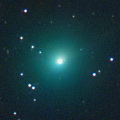
|
Getting brighter much faster than expected. Now it is so bright as 6.9 mag (Jan. 17, Chris Wyatt). It will approach to the sun down to 0.73 A.U. in March. It may brighten up to 3 mag at best. In the Southern Hemisphere, it keeps observable while brightening gradually after this in good condition. In the Northern Hemisphere, it is not observable now. It becomes observable again in May, and it keeps observable in good condition after that while fading gradually.
Date(TT) R.A. (2000) Decl. Delta r Elong. m1 Best Time(A, h)
Jan. 19 12 29.74 -58 59.5 1.111 1.404 83 7.4 4:36 ( 0, -4)
Jan. 26 12 46.74 -70 31.6 1.031 1.305 80 6.6 4:25 ( 0,-15)
|
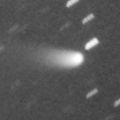
|
Now it is 7.6 mag (Jan. 19, Michael Mattiazzo). Although it had been brightening as expected until late December, the brightening has got slow down in January. It was expected to be a great comet of -1 mag in spring, however, it may brightens only up to 3 mag at best. In the Southern Hemisphere, it keeps observable in the low sky until mid February. In the Northern Hemisphere, it keeps unobservable for a long time until March.
Date(TT) R.A. (2000) Decl. Delta r Elong. m1 Best Time(A, h)
Jan. 19 18 15.25 -43 6.5 1.983 1.264 32 7.6 5:37 (315,-11)
Jan. 26 18 47.18 -44 29.7 1.803 1.129 33 7.1 5:35 (316,-13)
|
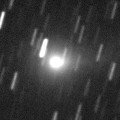
|
Long-lost comet for almost 200 years since 1827. Finally re-discovered by Rob Matson from SWAN images of mid November. Appearing in the morning sky again in the Northern Hemisphere. Now it is very bright as 8.7 mag (Jan. 20, Juan Jose Gonzalez). It can brighten furthermore after the perihelion passage. In the Northern Hemisphere, it keeps observable in excellent condition while fading after this. In the Southern Hemisphere, it is only observable in low sky from February to March.
Date(TT) R.A. (2000) Decl. Delta r Elong. m1 Best Time(A, h)
Jan. 19 18 39.86 -1 28.2 1.741 0.986 27 8.4 5:37 (279, 10)
Jan. 26 18 35.05 1 59.2 1.691 1.061 35 8.7 5:35 (280, 18)
|
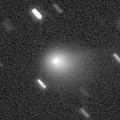
|
It brightened up to 9.0 mag in 2012 autumn (Nov. 4, Juan Jose Gonzalez). It is not observable now. In the Southern Hemisphere, it will appear in the morning sky at 9 mag in February, then it keeps observable in good condition while fading slowly. In the Northern Hemisphere, it is hardly observable after 2013.
Date(TT) R.A. (2000) Decl. Delta r Elong. m1 Best Time(A, h)
Jan. 19 19 5.87 -32 58.3 2.734 1.824 18 9.1 5:37 (301,-14)
Jan. 26 19 26.63 -34 40.6 2.711 1.833 21 9.1 5:35 (303,-14)
|
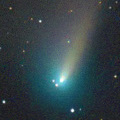
|
It approached to the earth down to 0.3 A.U. and brightened up to 7-8 mag from late December to early January. However, it will go away from the earth and fade out rapidly after this. It has already faded down to 9.9 mag (Jan. 12, Marco Goiato). It is observable in good condition also in the Southern Hemisphere after this.
Date(TT) R.A. (2000) Decl. Delta r Elong. m1 Best Time(A, h)
Jan. 19 4 16.35 -2 28.9 0.621 1.400 119 10.4 20:20 ( 0, 52)
Jan. 26 4 7.67 -8 5.8 0.807 1.464 109 11.2 19:44 ( 0, 47)
|
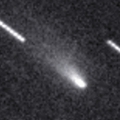
|
Now it is 11.6 mag (Jan. 18, Marco Goiato). Diffuse, but visible visually. It approaches to the Sun down to 0.3 A.U. in February. The ephemeris says it will brighten up to 7 mag. However, because the comet is small, it may be disintegrated. It keeps observable in good condition until February while brightening gradually.
Date(TT) R.A. (2000) Decl. Delta r Elong. m1 Best Time(A, h)
Jan. 19 0 19.87 -25 54.8 1.019 0.979 58 12.4 18:43 ( 33, 21)
Jan. 26 0 5.56 -28 25.6 1.023 0.836 49 11.8 18:49 ( 41, 13)
|
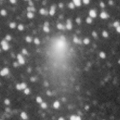
|
Now it is 13.4 mag (Jan. 17, Hidetaka Sato). It is expected to be observable at 11-13 mag for a long time from 2012 summer to 2013 summer. It will be getting higher gradually in the morning sky. Finally it becomes observable also in the Northern Hemisphere.
Date(TT) R.A. (2000) Decl. Delta r Elong. m1 Best Time(A, h)
Jan. 19 16 11.73 -30 13.6 2.801 2.343 52 12.4 5:37 (325, 15)
Jan. 26 16 13.67 -28 43.5 2.723 2.381 59 12.4 5:35 (329, 18)
|
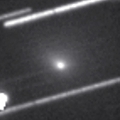
|
First return of a new periodic comet discovered in 1994. Although it had been fainter than expected, it brightened rapidly and reached up to 10.6 mag (Dec. 13, Katsumi Yoshimoto). It is bright as 11.6 mag still now (Jan. 11, Sandor Szabo). It has a large diffuse coma. It keeps locating high for a while, but it will be fading after this.
Date(TT) R.A. (2000) Decl. Delta r Elong. m1 Best Time(A, h)
Jan. 19 1 39.47 -7 58.2 1.181 1.421 81 12.7 18:43 ( 20, 45)
Jan. 26 2 3.72 -7 41.5 1.258 1.464 80 13.1 18:49 ( 24, 45)
|
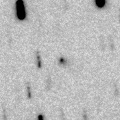
|
Now it is so bright as 11.8 mag (Jan. 3, Juan Jose Gonzalez). It keeps bright as 12 mag until spring. In the Northern Hemisphere, it keeps observable in good condition until April. It is not observable now in the Southern Hemisphere. It will become observable after April, but it keeps locating low.
Date(TT) R.A. (2000) Decl. Delta r Elong. m1 Best Time(A, h)
Jan. 19 0 53.10 57 48.7 1.744 2.121 98 13.0 18:43 (151, 61)
Jan. 26 1 14.83 53 55.8 1.739 2.059 94 12.8 18:49 (142, 62)
|

|
It brightened up to 11-12 mag in 2012. Now it is 13.5 mag (Jan. 16, A. Novichonok). It will be observable at 12-13 mag in good condition again in 2013.
Date(TT) R.A. (2000) Decl. Delta r Elong. m1 Best Time(A, h)
Jan. 19 15 34.56 -17 19.9 5.914 5.543 63 13.2 5:37 (326, 30)
Jan. 26 15 33.57 -17 24.2 5.810 5.563 70 13.1 5:35 (332, 33)
|
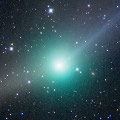
|
It kept as bright as 6-7 mag for a long time from 2011 summer to 2012 spring. Now it is fading. But it is very bright and visible visually at 14.0 mag still now (Dec. 13, Sandor Szabo).
Date(TT) R.A. (2000) Decl. Delta r Elong. m1 Best Time(A, h)
Jan. 19 9 16.58 -10 47.3 3.989 4.821 144 13.4 1:24 ( 0, 44)
Jan. 26 9 8.34 -10 56.7 4.014 4.885 149 13.5 0:48 ( 0, 44)
|
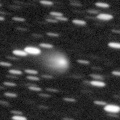
|
Now it is 13.3 mag (Nov. 15, Sandor Szabo). It keeps bright at 13-14 mag for a long time until 2014. It keeps observable for a long time in the Northern Hemisphere. It is not observable in the Southern Hemisphere.
Date(TT) R.A. (2000) Decl. Delta r Elong. m1 Best Time(A, h)
Jan. 19 20 54.96 30 38.4 6.510 5.962 52 13.7 18:43 (114, 20)
Jan. 26 20 57.89 30 13.9 6.550 5.955 49 13.7 18:49 (117, 14)
|

|
It brightened rapidly, and reached up to 12 mag in 2012. Appearing in the mornig sky again. It will be observable at 12-14 mag in good condition again in 2013. However, it locates somewhat low in the Northern Hemisphere in 2013.
Date(TT) R.A. (2000) Decl. Delta r Elong. m1 Best Time(A, h)
Jan. 19 17 34.95 -21 59.9 3.634 2.880 34 13.8 5:37 (305, 9)
Jan. 26 17 46.84 -22 25.4 3.577 2.880 39 13.8 5:35 (307, 11)
|
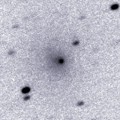
|
Now it is 11.0 mag (Jan. 8, Juan Jose Gonzalez). Extremely diffuse.
Date(TT) R.A. (2000) Decl. Delta r Elong. m1 Best Time(A, h)
Jan. 19 14 7.55 -22 27.7 6.301 6.234 81 14.0 5:37 (350, 32)
Jan. 26 14 9.47 -22 49.0 6.188 6.233 88 13.9 5:35 (356, 32)
|

|
Big asteroid discovered in 1906. It suddenly showed the cometary activity on Dec. 11, 2010, probably due to an impact of a small object. Now it is 11.9 mag (May 29, Marco Goiato). It has already turned to be stellar. It is not observable now.
Date(TT) R.A. (2000) Decl. Delta r Elong. m1 Best Time(A, h)
Jan. 19 20 47.84 -27 30.8 3.612 2.658 12 14.2 18:43 ( 66,-13)
Jan. 26 21 1.50 -26 46.4 3.632 2.669 10 14.2 18:49 ( 69,-17)
|

|
Now it is bright and visible visually at 12.9 mag (Jan. 3, Chris Wyatt). It keeps 12-14 mag until February. It keeps observable in good condition in the Northern Hemisphere. In the Southern Hemisphere, it will be getting lower gradually after this, and will be unobservable in late January.
Date(TT) R.A. (2000) Decl. Delta r Elong. m1 Best Time(A, h)
Jan. 19 0 48.82 18 26.7 3.209 3.186 79 14.2 18:43 ( 63, 61)
Jan. 26 0 58.28 18 4.9 3.310 3.195 74 14.3 18:49 ( 69, 56)
|
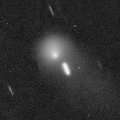
|
Now it is 14.9 mag (Jan. 5, A. Novichonok). It will be fading slowly after this. But it keeps 15 mag in 2013. It is observable in good condition in the Southern Hemisphere. It becomes observable in the extremely low sky from January to February in the Northern Hemisphere.
Date(TT) R.A. (2000) Decl. Delta r Elong. m1 Best Time(A, h)
Jan. 19 2 57.12 -46 14.8 6.155 6.132 84 14.3 19:01 ( 0, 9)
Jan. 26 2 55.93 -44 42.4 6.236 6.155 80 14.3 18:49 ( 3, 10)
|
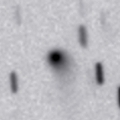
|
It is expected to keep 13 mag and observable in good condition in the Northern Hemisphere for a long time from 2013 to 2014. Now it is 15.0 mag (Jan. 9, A. Novichonok). It will be observable also in the Southern Hemisphere from early December to early March, although it locates low.
Date(TT) R.A. (2000) Decl. Delta r Elong. m1 Best Time(A, h)
Jan. 19 11 21.69 31 24.7 3.866 4.610 134 14.6 3:29 ( 0, 86)
Jan. 26 11 16.02 33 30.7 3.763 4.571 140 14.5 2:56 ( 0, 88)
|
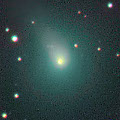
|
It brightened much faster than expected, and reached up to 10.0 mag in summer (Aug. 9, Juan Jose Gonzalez). Now it is fading, but it is bright as 13.8 ma still now (Jan. 11, Sandor Szabo). It keeps observable in good condition for a while after this.
Date(TT) R.A. (2000) Decl. Delta r Elong. m1 Best Time(A, h)
Jan. 19 7 45.77 12 23.3 1.993 2.968 170 14.6 23:48 ( 0, 67)
Jan. 26 7 30.09 10 49.9 2.067 3.021 162 14.9 23:05 ( 0, 66)
|
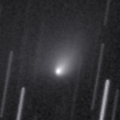
|
Now it is visible visually at 13.7 mag (Dec. 23, Juan Jose Gonzalez). It keeps 15 mag until March. In the Northern Hemisphere, it keeps observable for a long time until the comet fades out. It is not observable in the Southern Hemisphere, except for 2013 spring, but the comet locates extremely low only.
Date(TT) R.A. (2000) Decl. Delta r Elong. m1 Best Time(A, h)
Jan. 19 3 23.81 63 18.2 1.657 2.280 117 14.7 19:29 (180, 62)
Jan. 26 3 29.23 57 22.1 1.717 2.291 113 14.8 19:07 (180, 68)
|
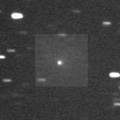
|
Now it is 15.7 mag (Jan. 11, Sandor Szabo). It is fainter than originally predicted by 1 mag. It will brighten up to 14 mag until spring. In the Northern Hemisphere, it keeps observable in excellent condition. In the Southern Hemisphere, it keeps locating extremely low for a while.
Date(TT) R.A. (2000) Decl. Delta r Elong. m1 Best Time(A, h)
Jan. 19 10 29.50 36 38.7 1.230 2.110 144 15.2 2:37 (180, 88)
Jan. 26 10 26.24 36 30.8 1.175 2.085 149 14.9 2:06 (180, 89)
|
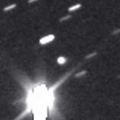
|
Now it is 15.2 mag (Jan. 11, Sandor Szabo). Already visible visually. It is expected to be a great comet in 2013 autumn when the comet approaches to the sun down to only 0.01 A.U. It keeps visible with naked eyes from November to January, and can be extremely bright as Venus or more at the highlight. The condition is excellent in the Northern Hemisphere. It keeps observable almost all through the period of brightening, at the highlight, and of fading. The condition is not good in the Southern Hemisphere. It is not observable at all the latter part of the highlight, and it keeps low all through the period.
Date(TT) R.A. (2000) Decl. Delta r Elong. m1 Best Time(A, h)
Jan. 19 7 32.15 31 27.1 4.106 5.069 166 15.6 23:35 ( 0, 86)
Jan. 26 7 24.24 31 37.9 4.058 4.993 159 15.5 23:00 ( 0, 87)
|

|
New bright comet discovered at 15 mag in late December. It must have been bright as 13-14 mag and observable in good condition from spring to autumn in the Southern Hemisphere. But it was not discovered. It will be fainter than 18 mag in April, and keeps observable in good condition. It will be observable also in the Northern Hemisphere after this in the evening sky while fading gradually.
Date(TT) R.A. (2000) Decl. Delta r Elong. m1 Best Time(A, h)
Jan. 19 5 15.84 -49 37.2 2.120 2.497 100 15.6 21:19 ( 0, 6)
Jan. 26 5 12.99 -45 37.1 2.172 2.554 101 15.8 20:49 ( 0, 10)
|
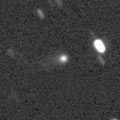
|
Now it is 14.8 mag (Jan. 9, A. Novichonok). It keeps 15-16 mag until February. It keeps observable in good condition for a long time until the comet fades out in the Northern Hemisphere. It is not observable until 2013 summer in the Southern Hemisphere. By the way, Juan Jose Gonzalez reported it extremely bright as 10.4 mag visually on Nov. 6.
Date(TT) R.A. (2000) Decl. Delta r Elong. m1 Best Time(A, h)
Jan. 19 0 21.82 59 17.8 3.376 3.603 95 15.8 18:43 (148, 57)
Jan. 26 0 27.84 56 33.0 3.482 3.615 89 15.9 18:49 (141, 55)
|
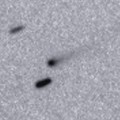
|
Now it is 17.1 mag (Dec. 12, Hidetaka Sato). It keeps bright as 13-14 mag for a long time from 2013 to 2014.
Date(TT) R.A. (2000) Decl. Delta r Elong. m1 Best Time(A, h)
Jan. 19 14 32.18 -9 39.5 3.686 3.649 80 16.0 5:37 (339, 43)
Jan. 26 14 37.16 -10 2.5 3.568 3.633 85 15.8 5:35 (346, 44)
|
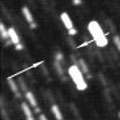
|
Now it is 16.2 mag (Dec. 25, K. Hills). In the Southern Hemisphere, it will be observable at 15-16 mag in good condition for a long time until 2013 summer. It is not observable at all in the Northern Hemisphere.
Date(TT) R.A. (2000) Decl. Delta r Elong. m1 Best Time(A, h)
Jan. 19 0 10.30 -71 34.2 4.483 4.112 61 15.9 18:43 ( 12,-20)
Jan. 26 0 30.83 -69 57.9 4.499 4.132 62 15.9 18:49 ( 14,-19)
|
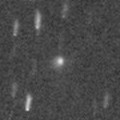
|
Now it is 16.5 mag (Dec. 8, Ken-ichi Kadota). It will brighten up to 12 mag from summer to autumn in 2013. In the Northern Hemisphere, it is observable only until spring when the comet brightens up to 15 mag. In the Southern Hemisphere, it keeps unobservable until August. Then it keeps observable while fading gradually.
Date(TT) R.A. (2000) Decl. Delta r Elong. m1 Best Time(A, h)
Jan. 19 23 22.27 54 55.7 2.982 3.080 86 16.3 18:43 (136, 51)
Jan. 26 23 38.27 53 33.7 2.975 3.009 82 16.2 18:49 (134, 49)
|

|
It kept as bright as 11-12 mag for a long time from 2011 autumn to 2012 spring. Now it is fading. It has already faded down to 17.0 mag (Jan. 11, V. Gerke, S. Plaksa, A. Novichonok). It keeps observable in good condition until spring while the comet will be fading gradually.
Date(TT) R.A. (2000) Decl. Delta r Elong. m1 Best Time(A, h)
Jan. 19 10 33.43 1 13.4 2.531 3.335 138 16.3 2:41 ( 0, 56)
Jan. 26 10 29.68 1 30.1 2.500 3.367 146 16.4 2:09 ( 0, 56)
|
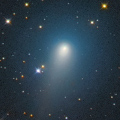
|
It brightened very rapidly and unusually, and reached up to 10 mag. It is bright as 11.3 mag still now (Dec. 8, Carlos Labordena). However, it is getting diffuse rapidly. It keeps high for a long time in the Northern Hemisphere. But the comet will be fading after this. It is not observable after this in the Southern Hemisphere. The nuclear split was observed in late October.
Date(TT) R.A. (2000) Decl. Delta r Elong. m1 Best Time(A, h)
Jan. 19 1 53.94 43 50.6 1.362 1.841 102 16.7 18:43 (140, 78)
Jan. 26 2 12.44 43 57.3 1.459 1.887 99 17.3 18:49 (133, 76)
|
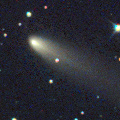
|
First return of a new periodic comet which brightened up to 14 mag in 2005. It brightened very rapidly, became much brighter than originally expected, and reached up to 11-12 mag. Now it is fading. But it is bright as 15.2 mag still now (Dec. 27, Yasukazu Ikari). It keeps high for a long time in the Northern Hemisphere. It locates very low in the Southern Hemisphere.
Date(TT) R.A. (2000) Decl. Delta r Elong. m1 Best Time(A, h)
Jan. 19 2 40.30 38 47.4 1.442 1.998 109 16.8 18:46 (180, 86)
Jan. 26 2 53.41 38 31.6 1.548 2.042 105 17.2 18:49 (136, 85)
|

|
It reaches up to 15-16 mag from spring to summer. It is observable in excellent condition in the Southern Hemisphere. It locates low in the Northern Hemisphere. No observations have been reported since last September.
Date(TT) R.A. (2000) Decl. Delta r Elong. m1 Best Time(A, h)
Jan. 19 16 51.11 -49 23.1 4.127 3.543 47 17.1 5:37 (330, -5)
Jan. 26 16 52.37 -49 20.7 4.019 3.523 53 17.0 5:35 (333, -3)
|
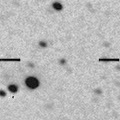
|
Now it is 16.4 mag (Jan. 6, J. F. Hernandez). It is expected to brighten up to 6 mag in 2014 autumn. In 2013, it keeps observable in good condition until autumn when it brigthens up to 14 mag.
Date(TT) R.A. (2000) Decl. Delta r Elong. m1 Best Time(A, h)
Jan. 19 17 23.69 8 30.9 7.412 6.805 48 17.2 5:37 (282, 31)
Jan. 26 17 26.06 8 51.0 7.279 6.745 53 17.1 5:35 (286, 36)
|

|
Now it is 17.4 mag (Jan. 5, K. Hills). It keeps observable in good condition at 17 mag from January to June. It locates somewhat low in the Southern Hemisphere.
Date(TT) R.A. (2000) Decl. Delta r Elong. m1 Best Time(A, h)
Jan. 19 9 23.20 16 30.0 1.228 2.182 160 17.3 1:31 ( 0, 71)
Jan. 26 9 19.37 17 19.1 1.184 2.158 169 17.2 0:59 ( 0, 72)
|
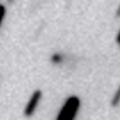
|
It was identified with an old comet discovered in 1931 by Tombaugh. It was unusually bright as 12.5 mag in 1931. Now it is 17.5 mag (Dec. 4, Mt. Lemmon Survey). It keeps 17.5 mag until March, and keeps observable in excellent condition in the Northern Hemisphere. It locates low in the Southern Hemisphere.
Date(TT) R.A. (2000) Decl. Delta r Elong. m1 Best Time(A, h)
Jan. 19 6 51.59 34 46.4 1.513 2.455 158 17.3 22:55 ( 0, 90)
Jan. 26 6 47.03 35 27.0 1.542 2.451 151 17.3 22:23 (180, 90)
|
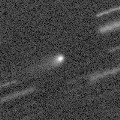
|
Now it is 17.8 mag (Jan. 11, P. Dupouy, et al.). It brightened up to 16.5 mag in 2012. It will be observable in good condition again at 17.5 mag in 2013 spring.
Date(TT) R.A. (2000) Decl. Delta r Elong. m1 Best Time(A, h)
Jan. 19 14 19.25 1 51.4 5.862 5.895 87 17.5 5:37 (339, 55)
Jan. 26 14 16.87 2 12.7 5.748 5.910 94 17.5 5:35 (350, 57)
|
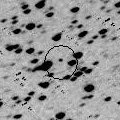
|
Peculiar asteroid moving along a cometary orbit. Now it is 17.3 mag (Dec. 6, E. Cozzi). It keeps observable at 18 mag for a long time from 2008 to 2014. It locates extremely low in the Southern Hemisphere.
Date(TT) R.A. (2000) Decl. Delta r Elong. m1 Best Time(A, h)
Jan. 19 7 22.15 40 51.0 6.242 7.162 157 17.6 23:25 (180, 84)
Jan. 26 7 16.11 41 21.6 6.290 7.175 152 17.6 22:52 (180, 84)
|
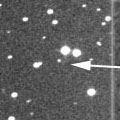
|
Now it is 17.2 mag (Dec. 31, Yasukazu Ikari). It will be observable at 17-18 mag for a long time from 2013 to 2014.
Date(TT) R.A. (2000) Decl. Delta r Elong. m1 Best Time(A, h)
Jan. 19 12 22.35 4 28.5 3.440 3.963 115 17.7 4:29 ( 0, 59)
Jan. 26 12 23.20 4 27.1 3.339 3.953 122 17.6 4:02 ( 0, 59)
|
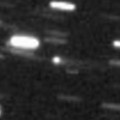
|
Now it is 17.7 mag (Jan. 11, V. Gerke, S. Plaksa, A. Novichonok). It reached up to 17 mag in last winter between 2011 and 2012. It will be observable in good condition again at 17.5 mag in this winter.
Date(TT) R.A. (2000) Decl. Delta r Elong. m1 Best Time(A, h)
Jan. 19 9 34.23 16 21.6 3.224 4.154 158 17.7 1:42 ( 0, 71)
Jan. 26 9 30.38 16 39.2 3.199 4.163 166 17.7 1:10 ( 0, 72)
|
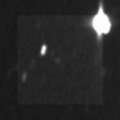
|
It is expected to brighten up to 11 mag and become observable in excellent condition in 2014 spring. Now it is 17.9 mag (Jan. 3, Toshiyuki Takahashi). In the Northern Hemisphere, it keeps observable in good condition until early summer. It locates low in the Southern Hemisphere.
Date(TT) R.A. (2000) Decl. Delta r Elong. m1 Best Time(A, h)
Jan. 19 9 22.73 35 10.8 3.910 4.832 157 17.8 1:30 (180, 90)
Jan. 26 9 17.79 36 8.9 3.832 4.769 160 17.7 0:58 (180, 89)
|
|
![]()
 C/2012 A2 ( LINEAR )
C/2012 A2 ( LINEAR ) 117P/Helin-Roman-Alu 1
117P/Helin-Roman-Alu 1 C/2011 O1 ( LINEAR )
C/2011 O1 ( LINEAR ) C/2012 V2 ( LINEAR )
C/2012 V2 ( LINEAR ) 78P/Gehrels 2
78P/Gehrels 2 168P/Hergenrother
168P/Hergenrother 260P/2012 K2 ( McNaught )
260P/2012 K2 ( McNaught ) C/2012 K6 ( McNaught )
C/2012 K6 ( McNaught ) C/2012 K1 ( PanSTARRS )
C/2012 K1 ( PanSTARRS ) 175P/Hergenrother
175P/Hergenrother 274P/2012 WX32 ( Tombaugh-Tenagra )
274P/2012 WX32 ( Tombaugh-Tenagra ) C/2010 R1 ( LINEAR )
C/2010 R1 ( LINEAR ) 2008 YB3
2008 YB3 P/2012 B1 ( PanSTARRS )
P/2012 B1 ( PanSTARRS ) 244P/2010 Q1 ( Scotti )
244P/2010 Q1 ( Scotti ) C/2012 X1 ( LINEAR )
C/2012 X1 ( LINEAR )![]()



































